Introduction
So far, in our attempts to
restore the bore proportions of Potter's old flute, we've tried several
treatments, but only Plan B, heavy
humidification, appears to have done much at all. And what it did
do was a little confusing. We'd hoped that the heavily compressed
tenons would magically reconstitute. They did reconstitute a
little, but not enough, but the startling effect was that the whole
section gained diameter. At first we thought this might be due to
hysteresis, but a subsequent experiment
suggests this isn't the explanation. That only leaves us with the
scary thought that the binding of the tenons at both ends had actually
compressed the entirety of the section. If that were so, then this
flute is operating significantly outside of the maker's original
intentions. Clearly, we need to get to
the bottom of this. But how?
One possible line of
investigation is to try a different reconstituting approach and see if
that produces the same result, a greater or lesser enlargement, or none.
Plan A, just playing, and Plan C, simulated playing, proved not
particularly effective at introducing moisture and motivating change. I think it's time
we got a whole lot more bold. And to do so, we're going to invoke one of
the great innovations of Potter's own era. Steam!
Speaking of steam
We can't slip into this though without a sideways glance toward one of
the great names associated with the development of steam power, James
Watt. Watt's dates are similar to Potter's. Seems he also had an interest in flutes ....
"As a young instrument
maker in Glasgow, Watt may have found the going hard. As well as
scientific instruments he sold musical instruments like violins,
flutes, bagpipes and guitars. Watt wasn't particularly
interested in music but with less demand for scientific instruments
than he had anticipated, the sale of musical instruments may have
provided an extra source of income.
In the 1760s fashionable young men considered learning the flute as
a respectable pastime. From the 1730s Thomas Lot had made high
quality flutes for players and aristocratic families across Europe.
But while Lot was the Stradivarius of the flute world, many lesser
makers sold flutes for only a few shillings each. There is a
possibility that young Watt counterfeited copies of the finest
flutes available in the seventeenth century.
The evidence is in James Watt's garret workshop. This was presented
in its entirety to the Science Museum in 1924 and it remained
virtually untouched following Watt's death in 1819.
Curator Michael Wright discovered a number of flute-making tools
among the workshop's contents. These include a crude stamp for
marking wooden goods with the maker's name. The stamp has four
letters: T LOT. To an amateur it presents a 'very passable
imitation' of the stamp officially used by Thomas Lot.
What was the stamp doing among Watt's possessions? Being short of
money, Watt may have marked his own cheap flutes as being made by
Lot, in order to sell them for more profit. A real musician wouldn't
mistake a Watt flute for a Lot flute but a gullible amateur might
easily do so."
(From "Making
the modern world - James Watt, life and inventions".
You can
also see some of
Watt's flute-making tools. Follow the link, press
Continue, choose Explore the Garret Workshop, and press Flutemaking
Tools.)
Steaming flutes?
So, what's the attraction of steam in the context of
reconstituting a strangled flute? Lots of things, we hope.
We can expect faster results in terms of how quickly the moisture
penetrates, but also greater results, as the high temperatures
should also play a role by making the lignin, the glue that holds
wood together, more flexible. Just how much quicker and
greater, we will only learn from the experiment. That alone
makes it worth doing!
The Experiment
So what does Plan D entail? We've already permanently changed the
flute's LH section, so further experiments there might be inconclusive.
But the RH section pretty much escaped alteration, so let's see what
steam can do for it. Good at this time to review its current
condition. It's the section between X=200 and X=330mm in the graph
below:
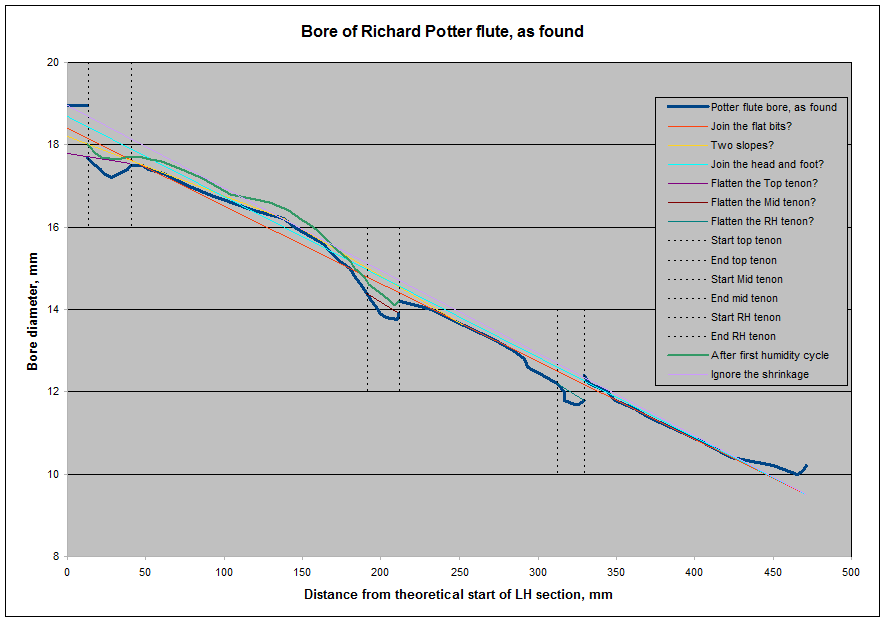
There appear to be two areas of suspicion in the RH section. The bore just after the
socket (X=210 to 220 in the graph above) appears to be narrowed. This is not
surprising, given that the original ivory ring is long gone and was
replaced by a crude brass one. The cylindrical brass ring appears
to have been hammered on to the taper at the start of the socket, with
the effect that a cylindrical crack has formed in the area where the
compression can be seen. Nasty bit of work, and not something we
normally have to deal with.
And there's the compression under the tenon (X= 310 to 330mm) and
probably in the lead-up to it (X=290-310mm). Now of course, we
don't know these are not original, but we certainly suspect they aren't.
It would be fabulous if a miraculous recovery proved we were right, but
that might be too much to hope.
And of course there's the new question, prompted by our experience in
Plan B. Will the RH section grow like the LH section did?
And will that tell us anything?
Steaming or Cooking?
About now I had an attack of Gung-Ho, and decided to really push the
limits. It was probably a reaction to the profound under-excitement of Plans A
and C. Instead of judicious use of steam (is there such a thing?),
I decided to pressure cook the section. As you probably know, a
pressure cooker heats steam up to about 120˚C by approximately
doubling the normal air pressure, taking it some 20˚C above
water's normal boiling point at sea level. This should be
interesting....
The Rake of Spuds
While we wait for the pressure cooker to come up, just time for an aside on matters cultural. Here's the quick'n'tasty way to produce that essential Irish-Australian culinary
masterpiece, the Rake of Spuds*. Wash a dozen or so small new-season potatoes and cook in their jackets for 11 minutes in the pressure
cooker (or until just nicely cooked). Unload into a warmed bowl,
smear with a little butter, season with salt and freshly ground pepper,
sprinkle with chopped parsley and consume with the fingers. Useful
these pressure cookers, eh, and not just for cooking flutes!
*I think I first heard this name for this dish from "Little Joe" Conlon,
who has also been the source for a few good songs.
Back to the flute....
Hoping for quick
results, I decided to check after just 10 minutes. Probably a good
thing!
The graph below records what happened. It's important to note that
the horizontal axis is not to scale. If it were, it would be hard
to see what was going on as the cooking intervals would be negligibly
narrow blips. So remember to read the X axis time intervals
carefully.
The measurement parameters are:
-
Weight of the section (in navy)
-
the maximum and minimum diameters of the socket
(mustard and pink), and
-
the maximum and minimum diameters of the tenon
(aqua and purple).
Of these, the tenon diameters are of the most
interest, as we hope they will increase substantially to shuck off
all those years compression.
You'll see I've normalised all the measurements and expressed them as
percentages, so they can be read on the same scale. As we start,
column 1, they all stand at zero.
Cooking
After only 10 minutes of steaming in the pressure cooker, it's clear that
action is indeed rapid. Incidentally, I'd gone a bit soft and only
used the "vegetable" weight, rather than the full "meat" regulator
weight on the cooker. So we've probably only been up around 110˚C.
I may need to use that in my defence! The weight has only gone up by 2% (not bad
in itself) but the dimensions have risen by 4 to 6%! I decide to
give it one more blast. After a further 10 minutes, I call it
quits. Weight now up 4%, but dimensions from 6 to 8%.
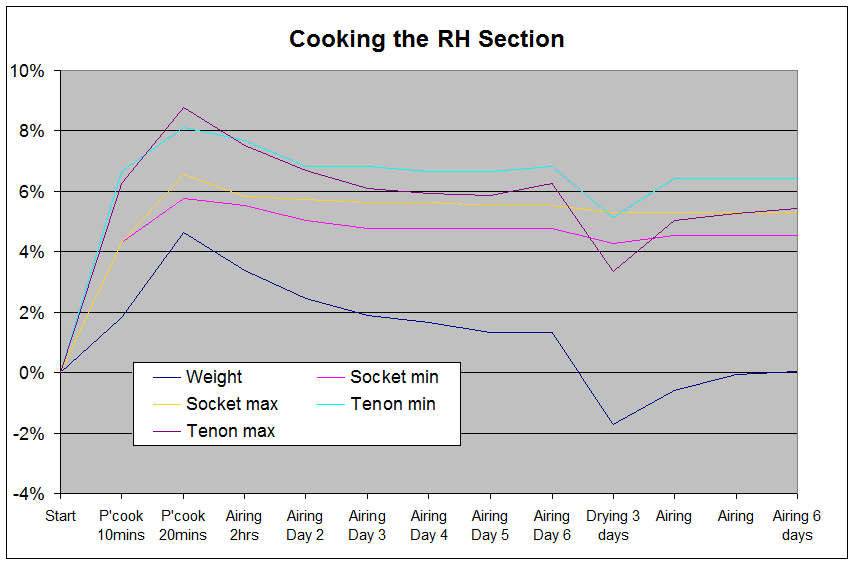
Interesting to compare that with the Heavy Humidification approach we
had applied to the LH section, as shown in the graph replicated below.
It had taken 10 days to achieve dimensional changes up to 8%, and it
required a similar increase in moisture levels. Here we've
achieved the same thing in 20 minutes, with only half that moisture
intake! The power of steam!
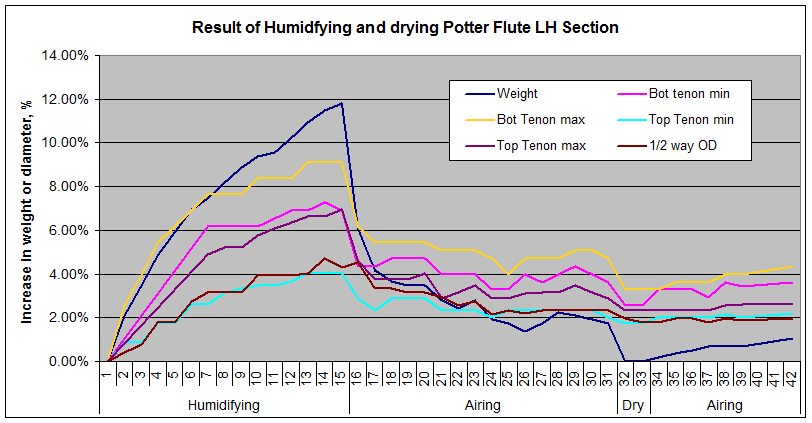
But it's not without impact on the flute section. Potter applied a
varnish to the outside of his flutes, and this section was now looking
considerably darker than the rest of it. Not a big deal in my case, as
a lot of the varnish has been scratched off over the years, but probably
not good to do to a nicely varnished flute. And where the varnish
is missing, the grain has been raised, so not good to do to nicely
polished flutes unless you are prepared to refinish them. Which is
possibly going to cause problems in terms of preserving the maker's
mark! Heh heh, thinking about it, what's the value of a maker's
mark when the operating conditions he'd carefully set up are lost?
The high temperature also far exceeds what superglue can live with, so
the cracks I had closed up earlier were now open wide. That
probably casts some doubt on the precise validity of the socket
measurements from here on, but the tenon measurements are uncompromised,
as well as being of more interest to us.
Airing, Drying, Airing
Getting the moisture back out takes a lot longer! I let it air on
the bench for 6 days, before giving up on the natural process. It
was behaving just like the LH piece - refusing to drop to the original
weight or size. I decided to give it a downward nudge and so
popped it into the desiccator for three days. That pulled the
weight well below the original value, but didn't have that much effect
on the dimensions.

Airing on the bench over the next two days, the weight returned to
original, but the dimensions remained on average 5% larger than where
they had started. Just to be sure, I waited 6 more days, with no
further change. This bird has landed, but its feathers are still
up the tree.
Outcomes
So, time now to measure up the RH section carefully. And what do
we see? Something truly awe-inspiring! You can see it below,
in thick green, at the middle of screen, to be compared with the thick
navy line which represents the dimensions as found originally.
Five things are immediately evident:
-
the compression just
after the socket is gone. Indeed there's now a little
flare where once there had been compression. That's
possibly due to the opened crack, and can be corrected by
closing the crack and installing a replacement ring.
-
the compression at
the tenon has disappeared almost entirely. This is
stunning news - the very question that got us into this whole
business appears answered! Can it be this easy?
-
the compression just
above the tenon is much ameliorated. It seems to suggest
that it was indeed an artefact of the tenon compression.
-
the once bent bore
now reasonably approximates a straight line. Remember Dr.
Bigio's observation that reamers of the period are unlikely to
involve compound tapers?
-
the whole section is
now larger, by an average 4%. Remembering that 6% in pitch
terms is a semitone might help put it in perspective.
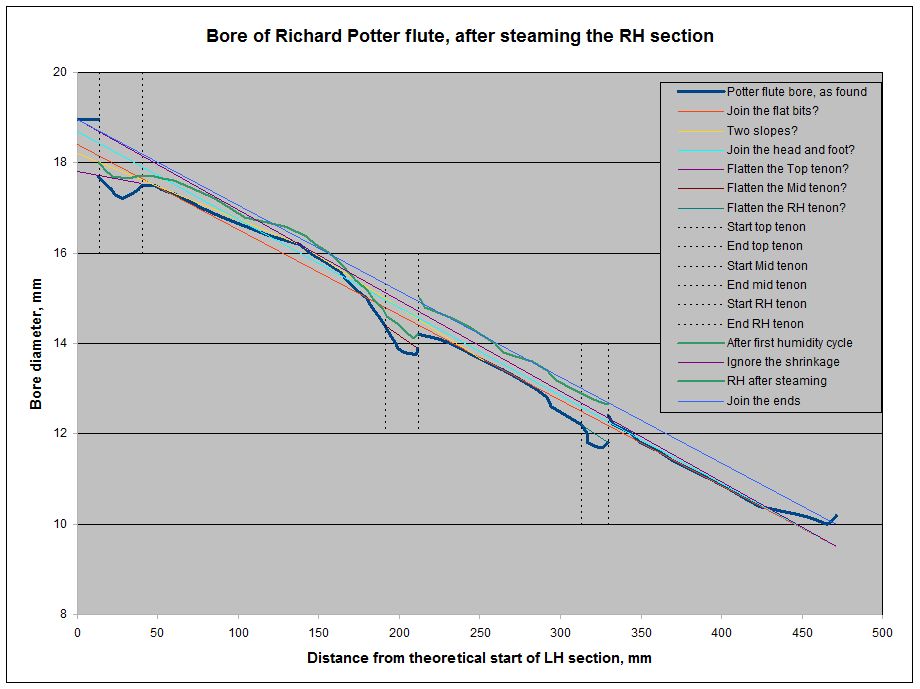
This is a cracking result! The test tenon in the first series had
proven that thread could crush the tenons, but also gave us the hope that
enough residual memory might remain to auto-reform, if the binding were
removed and the conditions for sufficient wood mobility were met. The heavy
humidification process in Plan B met some of those conditions, but not
enough to reconstitute fully. But just twenty minutes in the
pressure cooker reversed 200 years of oppression!
And does this invite us to propose a yet more radical scenario, "Join
the ends", as illustrated by the thin blue trace in the graph above?
Fits nicely with the newly reconstituted RH. Aligns well with the
largest part of the reconstituted LH. But only touches the
so-far-untouched foot at its distal end.
Looking back though, the "just flatten the tenons" scenario suddenly
looks very meek!
A step too far?
So, a 4% increase in diameter? Is that
something we want, or something we can live with? Has pressure
cooking expanded the section back to where Mr Potter intended, or
beyond that into uncharted waters? Could this even happen? And
how would we know anyway?
One disturbing indicator is the socket on the foot.
It can no longer accept the enlarged tenon at the end of the RH
section. But is that a argument against the enlarged tenon or
against the shrunken socket? This socket too had lost its
ivory ring sometime back, to have it replaced by one crudely
fashioned in brass. Like the RH socket, this cylindrical ring
had also been hammered on over a tapered section of wood,
compressing it. Not much evidence left there, Inspector.
A nervous speculation
Imagine this. A timber-getter cuts down some
boxwood in the forest. The trunk is cut up into lengths and
riven lengthwise to prevent splitting. The timber is stored
under shelter to season.
Water evaporates from the surface, causing it to
shrink with respect to the wetter timber inside. Pressures
build up. If the evaporation rate is too high, the timber will
split. If the people running the seasoning have managed things
well, it won't, just. Slowly, slowly, moisture migrates from
the damp interior through the drier exterior and to atmosphere.
The dry exterior band gets thicker and thicker, leaving a
diminishing core of damper wood, under increasing pressure.
Slowly slowly, the damper core dries out until all is close to
moisture equilibrium.
Mr Potter buys the wood and bores and reams out its
interior. The outer timber is still exerting pressure inwards.
Then he turns off the outside, leaving walls just 4mm thick.
The thin remaining wood is neither inner or outer wood, but from
somewhere in between. Will the locked-in pressure be inwards
or outwards, or nicely balanced? Maybe it doesn't matter to
Potter - either way, the timber is dry now and so has little
mobility.
Supposing Mr Potter had popped the freshly turned
flute section into an early pressure cooker right then and there,
then let it air dry again? Would the diameter have
shrunk or grown, or stayed where it was? Is it possible that
we've just released pressures that originate right back when the
timber was first seasoned, as well as releasing those pressures
added later by overtight ring and tenon threading?
Ask the family!
Ah, but we're forgetting something aren't we!
We've forgotten to Ask the Family whether this new enlarged RH
section, and indeed, the slightly less enlarged LH section, still
fit within family expectations. Let's add these new dimensions
to the graph we developed back in
Musings.
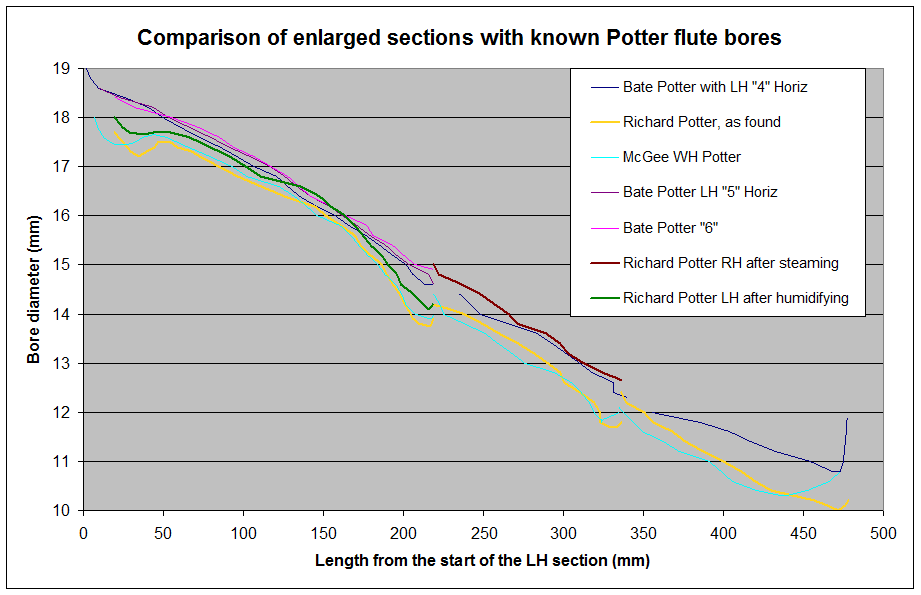
Ah, now suddenly that doesn't look so outlandish,
does it. The pressure-cookered RH (thick brown) extends nicely
from the largest of the three corps de rechange from the Bate flute
and is close to if just a little larger than the Bate flute's RH
section. The humidified LH (thick green) approximates the Bate
flute at the middle but is still very compressed at and near the
tenons at both ends. But, if no longer outlandish, it's still
pretty staggering!
The power to crush
Back in Series 1, we went
to some pains to illustrate the kind of forces that thread wrapping
could set up. And, it has to be said, many readers struggled
to believe. I'm hoping that this experiment will put that
behind us forever. Water dripping on a stone may not produce
much effect over the period of a minute, an hour, or a day.
But, 10 or 200 years later ....
Where to now?
So have we found the way
of the future? Just gather up all the old flutes and slap them
in a big pressure cooker for 20 minutes to enable them to recover
their lost youth? Or can we come up with a more gentle regime
that will achieve the same thing, or at least achieve enough that we
can honestly say this is the flute the maker intended and not some
mangled travesty of it?
We certainly need to do
something still with the tenons on the LH section, and the foot of
the flute isn't much good to us if it won't go on the end! Can
we use them to find and prove that more gentle regime?
Conclusions
Well, wasn't that
stunning! We appear to have actually achieved what we set out
to do - enable at least one part of the strangled flute to
auto-restore to its original shape, and assert on the way what its
original shape was. But, if that is its original shape, the
rest of the flute has still some way to go to match it.
And if that is its
original state, it was a lot more strangled than I had thought.
Remember I'd chosen it and characterised it as "moderately
strangled"? So just how strangled were those severely
strangled flutes that got us in to this whole investigation?
But, this is no time for
hubris. We're not out of the woods yet!
On to A Test Tube, or
Back to McGee-flutes
Index page...
Created 22 June 2011
|